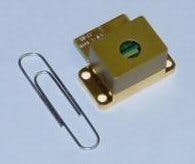Novalux laser-based light sources target projection devices
Green devices have already been developed, but the company still has to unveil a complementary red device to enable an RGB light source.
"The NECSEL-460-500, our first blue laser aimed at the microdisplay market, compliments the green NECSEL prototypes currently under evaluation by consumer electronics manufacturers," said Greg Niven, vice president of marketing for Novalux.
Novalux's prototype blue NECSEL device emits over 500 mW at 460 nm - the "true blue" coveted by display manufacturers. It is housed in a package smaller than a matchbox.
At the end of August 2005, Novalux announced a green device emitting over 500 mW at 532 nm. "Our next step is to make available even higher power devices, along with a red NECSEL source," said Niven.
Novalux claims that, once combined into a single RGB solid-state light source, the NECSEL lasers will significantly enhance display performance and enable simpler light engine architectures. "They are the key to displacing the ultra-high pressure (UHP) mercury vapour lamps currently in use for microdisplay illumination," said Niven.
Niven told LEDs Magazine that LEDs could be used for this application if they had higher power/brightness levels, but the lasers are more suitable due to their high etendue giving them much better coupling efficiency to the microdisplay.
All NECSEL sources produce color-saturated output, allowing them to reach a larger color space than competitive lighting technologies. They are also wavelength selectable, so integrators can create multi-primary laser displays that include colors such as cyan.
Moreover, NECSEL sources provide bright, speckle-free output, resulting in clear, vibrant images unattainable by any other lighting technology. Other advantages include long lifetime, instant-on, low étendue and low cost integration.
Novalux plans to demonstrate its NECSEL light sources in a prototype rear-projection TV during the Consumer Electronics Show (CES) in Las Vegas, Nevada, January 5-8, 2006.
"We are planning to show the first-ever laser-based rear-projection TV at CES 2006," said Niven. "This initial prototype TV will demonstrate our ability to dramatically increase display performance."






